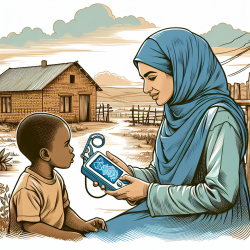In the realm of speech-language pathology, evidence-based practices are paramount. The study titled "Caregiver Perceptions of Children who have Complex Communication Needs Following a Home-based Intervention Using Augmentative and Alternative Communication in Rural Kenya: An Intervention Note" offers compelling insights that can guide practitioners in enhancing their interventions for children with complex communication needs. Here, we delve into the study's findings and discuss practical applications for speech-language pathologists.
Key Findings
- Significant Improvements in Communication: The study employed a pretest-posttest design and used an adapted version of the Communication Profile. The data revealed statistically significant positive changes in caregiver perceptions of communication at the levels of Body Structure and Function, and Activities for Communication.
- Enhanced Social Participation: Analysis of the Participation for Communication section showed an expansion in the children's social activities, indicating broader social engagement post-intervention.
- Cultural and Contextual Relevance: The intervention utilized locally-sourced, low-tech materials, making it both economically feasible and culturally appropriate for the rural Kenyan context.
Implications for Practitioners
1. Leverage Caregiver Expertise: The study underscores the importance of caregiver involvement. Practitioners should design interventions that empower caregivers to utilize their natural expertise, fostering a supportive home environment for the child's communication development.
2. Contextual Adaptation: Using locally available materials and culturally relevant methods can enhance the effectiveness of interventions. Practitioners should consider the socioeconomic and cultural contexts of the families they work with to ensure interventions are practical and sustainable.
3. Regular Monitoring and Support: The study highlighted the benefits of ongoing support and monitoring. Practitioners should establish regular follow-ups to provide feedback, make necessary adjustments, and reinforce intervention principles.
Encouraging Further Research
While the study provides promising preliminary evidence, further research is needed to validate these findings on a larger scale. Practitioners are encouraged to engage in or support research efforts that explore the long-term impacts of home-based AAC interventions in diverse settings.
Conclusion
The study from rural Kenya offers valuable lessons for speech-language pathologists worldwide. By focusing on caregiver involvement, contextual adaptation, and regular support, practitioners can enhance the communication outcomes for children with complex communication needs. To read the original research paper, please follow this link: Caregiver Perceptions of Children who have Complex Communication Needs Following a Home-based Intervention Using Augmentative and Alternative Communication in Rural Kenya: An Intervention Note.










